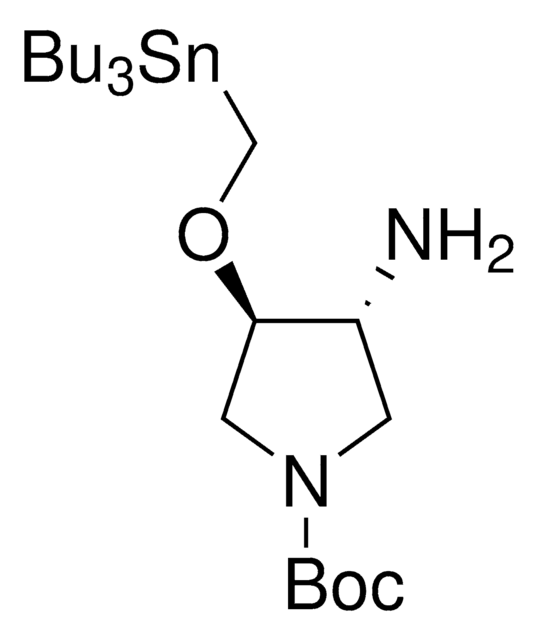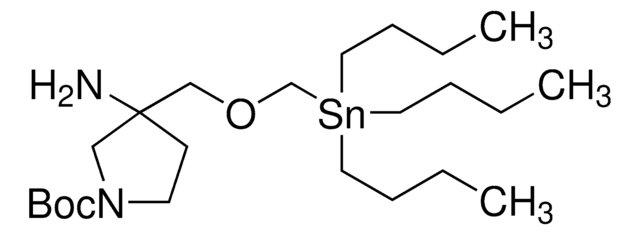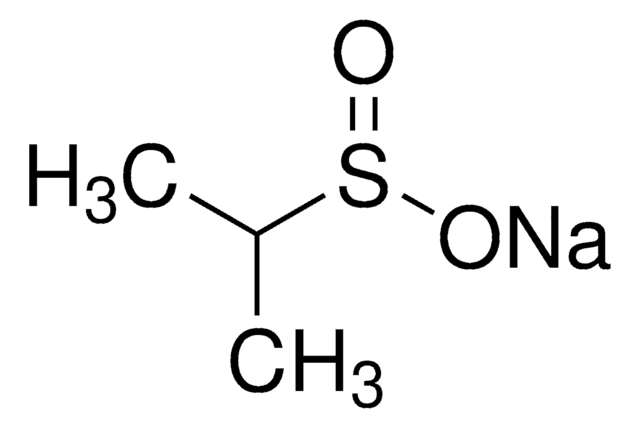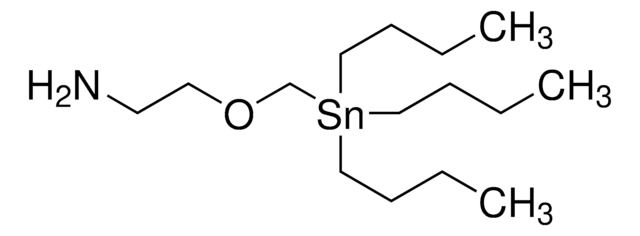Kluczowe dokumenty
804088
SnAP 2-Spiro-(4-Pip) M Reagent
Synonim(y):
4-(aminometylo)-4-((tributylostannylo)metoksy)piperydyno-1-karboksylan tert-butylu
About This Item
Polecane produkty
Formularz
liquid
współczynnik refrakcji
n/D 1.492
gęstość
1.146
grupa funkcyjna
amine
ether
temp. przechowywania
−20°C
ciąg SMILES
CCCC[Sn](CCCC)(COC1(CCN(C(OC(C)(C)C)=O)CC1)CN)CCCC
InChI
1S/C12H23N2O3.3C4H9.Sn/c1-11(2,3)17-10(15)14-7-5-12(9-13,16-4)6-8-14;3*1-3-4-2;/h4-9,13H2,1-3H3;3*1,3-4H2,2H3;
Klucz InChI
LEBKPKYDLQUOJO-UHFFFAOYSA-N
Opis ogólny
Zastosowanie
Zautomatyzuj tworzenie N-heterocykli dzięki platformie zautomatyzowanej syntezy Synple (SYNPLE-SC002).
Inne uwagi
Professor product portal: Jeffrey Bode Research Group
Odczynniki SnAP do syntezy piperazyn i morfolin
Odczynniki SnAP do jednoetapowej syntezy średniopierścieniowych nasyconych N-heterocykli z aldehydów
Odczynniki SnAP do krzyżowego sprzęgania w jednoetapowej syntezie nasyconych N-heterocykli
Niestandardowe odczynniki SnAP do syntezy C-podstawionych spirocyklicznych i bicyklicznych nasyconych N-heterocykli
produkt powiązany
Hasło ostrzegawcze
Danger
Zwroty wskazujące rodzaj zagrożenia
Zwroty wskazujące środki ostrożności
Klasyfikacja zagrożeń
Acute Tox. 3 Oral - Acute Tox. 4 Dermal - Aquatic Acute 1 - Aquatic Chronic 1 - Eye Irrit. 2 - Repr. 1B - Skin Irrit. 2 - STOT RE 1
Kod klasy składowania
6.1C - Combustible acute toxic Cat.3 / toxic compounds or compounds which causing chronic effects
Klasa zagrożenia wodnego (WGK)
WGK 3
Temperatura zapłonu (°F)
>230.0 °F
Temperatura zapłonu (°C)
> 110 °C
Wybierz jedną z najnowszych wersji:
Certyfikaty analizy (CoA)
It looks like we've run into a problem, but you can still download Certificates of Analysis from our Dokumenty section.
Proszę o kontakt, jeśli potrzebna jest pomoc Obsługa Klienta
Masz już ten produkt?
Dokumenty związane z niedawno zakupionymi produktami zostały zamieszczone w Bibliotece dokumentów.
Protokoły
Odczynniki SnAP ułatwiają syntezę nasyconych N-heterocykli dla różnych struktur.
Saturated N-heterocyclic building blocks or SnAP Reagents are of growing importance for the convenient synthesis of medium-ring saturated N-heterocycles, including bicyclic and spirocyclic structures. SnAP reagents are stable and readily available and can be coupled with widely available aromatic, heteroaromatic, aliphatic, and glyoxylic aldehydes.
Nasz zespół naukowców ma doświadczenie we wszystkich obszarach badań, w tym w naukach przyrodniczych, materiałoznawstwie, syntezie chemicznej, chromatografii, analityce i wielu innych dziedzinach.
Skontaktuj się z zespołem ds. pomocy technicznej











